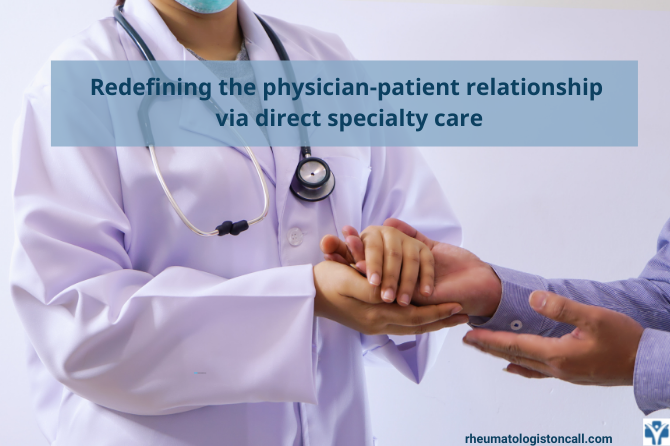SHARE
As physicians, redefining the relationship with our patients needs to become a priority. What is direct specialty care? Is this a new concept of practicing medicine?
NO. Direct specialty care is a revived concept. The goal is to regain the patient’s trust in the medical system and offer medical services that are accessible, directly contracted from physicians and costs are transparent.
Often, I find patients confused about who is responsible for their increased medical costs and lack of access. They think an insurance policy will cover them for medical services. However, patients are surprised to find that is not the case. Quite often, we hear that our medical system is broken. How can we help our patients? Let’s find out about a few of the problems that physicians are facing these days.
Physicians are often blamed for the failing of the medical system
Physicians are the interface between the patients and the medical system. When a patient is sick then they schedule an appointment. Patients wait on the phone at least 30 minutes to speak to someone in an office. They get frustrated if that office doesn’t take their insurance. When they finally get to be see, many times after months from the time of scheduling the appointment, then the time with the physician is very limited. Their questions remain unanswered due to lack of time. Patients blame the physicians as they spend more time looking at the computer and not to them. After visits, many surprise bills can follow, from the physician office, from tests and even from medications. Some tests get denied by insurance companies, some medication get denied as well.
Unfortunately, for many of these difficulties that arise from interacting with the medical system, patients blamed physicians.
Yes, physicians are blamed for the lack of patient access, increased costs, copayments, and surprise bills.
What is the truth?
As a physician previously employed in the traditional system, I can testify that there is minimal control of our schedule. As an employed physician, most of us, have no idea what is the cost of our consultation, what is the negotiated price with the patient insurance company. We are not aware or involved in setting up the price of laboratory, imaging, or medication. Patient were made to believe that our greed and increase in our salaries is generating higher costs of healthcare and increase in insurance premiums. This is false. Every year, we hear about the increase in the national healthcare spending. One year before COVID hit, the healthcare spending in the US hit $3.8 trillion. Did you know that physician salaries represent just 8.6% of the annual costs of the US healthcare system?
In the last 20 years, after adjusting for inflation, the Medicare reimbursements decreased to 29% . If physicians are paid less for their services, naturally, you will wander where are the rest of these money going?
Patients have decreased access to specialists
Patients are now required to have referrals to get to a subspecialist physician. The specialists needs the referral to receive payment from your insurance.
Even with a referral in their hand, patients have limited access to a specialist.
Why?
There are not enough specialists in your network.
The average waiting time to be seen is between 3 and 6 months, even worse in certain subspecialities.
Access to specialists can be somewhat more accessible if you are lucky to be located in a metropolitan area, on the west or east coast, where more specialists are concentrated in the big hospital systems. However, if you are located in a rural area, don’t be surprised that you are not having a specialist like me for hundreds of miles radius. Don’t be surprise that you need to travel for 2 hours to a close metropolitan area to have access to a specialist. That means many months worrying about your diagnosis, and many months of pain. Read this true story of a patient in a great metropolitan area without having access to a specialist for months despite carrying insurance.
Why is this happening?
Physicians trained in US are not allowed to practice in multiple states
Despite the fact that we are physicians trained in US, we are not allowed to practice in multiple states, unless we are licensed to practice in that state. This seems to be a limitation that does not serve the patients and is limiting us from practicing.
After passing the same USMLE exams, training in residency programs for which curriculum is approved by the ABIM, then going into subspecialty programs that are again approved by the same institutions we end up passing the ABIM boards to finally become board certified into our specialties.
But that is not enough. That is not giving us the right to practice across the state lines .
We are asked to license in each US state, then certify and maintain certification, that comply with the ABIM boards and also medical state board. Every one to two years we need to renew the license. All of these certifications, licensing, renewals cost us a lot of money. many physicians do not want to have that hassle of certifying in multiple states, it is a complicated and expensive process.
There are not enough specialists in the US
Yes, the truth is that are not enough physicians and even worse, that are not enough specialists in the US. Certain specialties are more affected than others. I recently commented about this matter in my latest article on KevinMD.com.
Why are not enough physicians in the US? In 1990’s, Medicare who supports the training programs in the US, limited the number of available training spots.
Additionally, insurance companies limit the number of specialists in their preferred provider panels.
And, if that wasn’t enough – because of the pressures on everyone’s schedules, subspecialists receive unnecessary consultations that might be better if they are sorted out at the primary care level. The relationship between primary care physicians and patients also suffered as physicians are short on time and not appropriately compensated for their work. At times, patients demand specialists referral. All of these can create a bottleneck limiting access to specialists.
Let’s redefine our relationship with patients
I am not going to pretend I can come up with a solution for all the problems in the medical system. If we want a change, then we have to work on that. If we just complain, nothing will get better.
A few suggestions that will improve access, cost and make us and our patients accountable.
First, removing licensing and accreditations barriers for physicians practicing in good faith in one US state and allowing them to practice in many states via telemedicine will increase patient access. As patients are comfortable on doing shopping or banking online, why cot get a medical consultation? We have the technology, we just have to use it. Telemedicine is here to broaden access and will remain as a viable and convenient option for patients. When I created Rheumatologist OnCall , my first goal was to broaden the access to rheumatology for patients. Patients from metropolitan or rural area should have the same access to a specialist. Despite being fully licensed and practicing in multiple US states, I cant see patients in all US states. However, there are so many patients from the states where I am not licensed that are reaching out to my company for help. Unfortunately, due to current licensing limitations, I am not able to help them.
Second, specialists should be allowed and their time compensated adequately for providing peer-to-peer consultations with primary care physicians. That will cut the time to wait for a consultation and decrease the costs significantly. When I started to offer peer to peer consultations, patients were served and physicians questions were answered.
Third, remove the “middlemen: from the interactions with patients. A physician is competent enough to provide medical care and advise the patient what workup and treatment are needed. Patients should trust their physician. A physician should be aware of consultations, laboratory services, imaging services, and treatment prices. Insurance companies should not deny or delay care by using their famous and tedious “pre-authorizations” processes.
Restore the relationship with patients via direct specialty care
Like me, many specialists took the Hippocratic Oath with the most incredible pride. Medical training is hard and requires years of sacrifice, days and nights away from your family and friends. Physicians spend four years in medical school, 3- 4 years in residency and another 2-3 years in fellowships. After all these years, the day that we can finally practice medicine arrives. All the physicians that I know have all the good intention to help patients. We promised not to harm, not even financially.
Direct specialty care is a revive of this concept, where patients and physicians are reunited. Physicians become easily accessible, accountable, transparent regarding the costs of their consultation. Physicians should advise patients what is in their best medical interest.
Patients have the right to choose who their physician is. They have the right to shop for their medical services. They have the right to know their medical costs before they are requested and if they are needed. Unless patients are in a medical emergency, they should be involved in the financial part of their medical care. In this way, patients do not end up in a financial crisis.
Contributors to this article
Diana Girnita MD, PhD is a rheumatologist practicing direct specialty care. Dr. Girnita started her practice Rheumatologist Oncall in 2020 to broaden access to her specialty. She has developed direct contracting with laboratory and imaging centers to offer transparent pricing for these services to patients. Dr. Girnita is practicing today in multiple US states. Dr. Girnita is an advocate for direct specialty care. She is frequently invited to discuss about this topic and is actively involved in helping other physicians and patients to understand and practice this concept.














